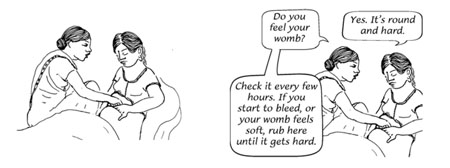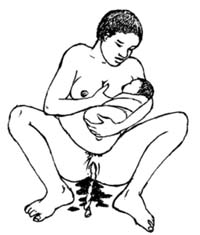11.4.3 Interventions during and after the third stage of labour
For women with no known risk factors, you can reduce the risk of PPH by correct and careful management of the third stage of labour, as described in Study Session 6. In summary, the main points to remember are as follows:
- After delivering the baby (and checking that there is no other baby left behind in the uterus), give the woman misoprostol 600 µg (micrograms) by mouth, or oxytocin 10 IU (international units) by intramuscular injection to help the uterus to contract.
- Do not apply fundal pressure to assist the delivery of the placenta.
- Rub the uterus immediately after the placenta is delivered, and at least every 15 minutes for the first 2 hours after birth to keep the uterus well-contracted. Teach the woman to massage and check her own uterus to keep it firm, and tell her to call for assistance if it is soft or if bleeding increases (Figure 11.2).

- Do a careful inspection for lacerations of the vagina, perineum and anus.
- Do a careful inspection of the placenta to ensure that it is intact (Study Session 6 showed how to do this).
- Help the mother to breastfeed the baby immediately after it is born – even before the placenta has delivered (Figure 11.3). When the baby sucks, the mother’s body makes its own oxytocin, which stimulates the uterus to contract at the same time as it stimulates the milk ducts to contract and let down milk into the baby’s mouth. Breastfeeding helps to deliver the placenta and reduce postpartum bleeding.

- Encourage the woman to empty her bladder immediately after the birth. The uterus may stay soft because the mother’s bladder is full. If she cannot urinate help her by trickling warm water over her abdomen. If this does not work, she may need to have a catheter (a plastic tube) put into her bladder to help her urinate.
You learned the principles of urinary catheterisation in Study Session 22 of the Antenatal Care Module and your practical skills training.
There are interventions you can make before, during and after labour which may help to reduce the risk of PPH. Quickly see how many of these you can list.
To check how well you answered, re-read Sections 11.4.1, 11.4.2 and 11.4.3 of this study session.
However, remember that even if you make all the interventions possible, postpartum haemorrhage can still occur unpredictably after any delivery and you should always be prepared to take emergency action, as described next.
11.4.2 Interventions during the second stage of labour
